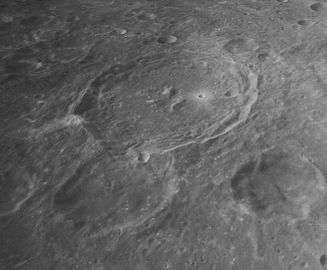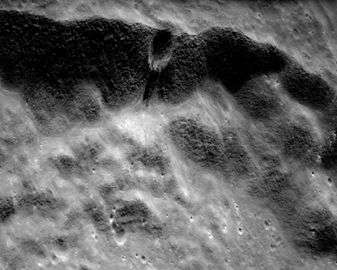Lobachevskiy
|
Apollo 16 panoramic camera image (rotated so that north is at top) | |
| Coordinates | 9°54′N 112°36′E / 9.9°N 112.6°ECoordinates: 9°54′N 112°36′E / 9.9°N 112.6°E |
|---|---|
| Diameter | 84 km |
| Depth | Unknown |
| Colongitude | 238° at sunrise |
| Eponym | Nikolai I. Lobachevsky |
Lobachevskiy is a lunar impact crater that is located on the far side of the Moon, beyond the eastern limb. This crater lies to the southeast of the larger crater Fleming. Less than a crater diameter to the east-northeast lies Guyot.
This is a well-formed crater with features that have not been significantly eroded since Lobachevskiy was first formed. The rim and inner wall are nearly free of significant overlapping impacts, although the satellite crater Lobachevskiy M is attached to the southern outer rim. The inner walls display terrace features, along with some slumping along the upper edge.
Near the midpoint of the interior floor is a pair of central peaks, with one to the southeast and the other to the northwest of the middle. To the east of these peaks is a relatively bright, high-albedo patch that is most likely the result of a recent small impact.
Two dark ribbons of material apparently emanate from the base of a small crater in the western wall of Lobachevskiy, and this was observed on the Apollo 16 mission.[1]
Prior to naming in 1961 by the IAU,[2] this crater was known as Crater 205.[3]
Views
 Low-altitude oblique close-up from Apollo 11
Low-altitude oblique close-up from Apollo 11 Oblique Apollo 16 mapping camera image
Oblique Apollo 16 mapping camera image Oblique Apollo 16 mapping camera image
Oblique Apollo 16 mapping camera image Small crater in the wall of Lobachevskiy with distinct flow lobes
Small crater in the wall of Lobachevskiy with distinct flow lobes
Satellite craters
By convention these features are identified on lunar maps by placing the letter on the side of the crater midpoint that is closest to Lobachevskiy.
| Lobachevskiy | Latitude | Longitude | Diameter |
|---|---|---|---|
| M | 8.0° N | 112.8° E | 41 km |
| P | 7.7° N | 111.3° E | 26 km |
References
- ↑ Apollo 16 Preliminary Science Report (NASA SP-315), 1972, Figure 28-23
- ↑ Lobachevskiy, Gazetteer of Planetary Nomenclature, International Astronomical Union (IAU) Working Group for Planetary System Nomenclature (WGPSN)
- ↑ Lunar Farside Chart (LFC-1A)
- Andersson, L. E.; Whitaker, E. A. (1982). NASA Catalogue of Lunar Nomenclature. NASA RP-1097.
- Blue, Jennifer (July 25, 2007). "Gazetteer of Planetary Nomenclature". USGS. Retrieved 2007-08-05.
- Bussey, B.; Spudis, P. (2004). The Clementine Atlas of the Moon. New York: Cambridge University Press. ISBN 978-0-521-81528-4.
- Cocks, Elijah E.; Cocks, Josiah C. (1995). Who's Who on the Moon: A Biographical Dictionary of Lunar Nomenclature. Tudor Publishers. ISBN 978-0-936389-27-1.
- McDowell, Jonathan (July 15, 2007). "Lunar Nomenclature". Jonathan's Space Report. Retrieved 2007-10-24.
- Menzel, D. H.; Minnaert, M.; Levin, B.; Dollfus, A.; Bell, B. (1971). "Report on Lunar Nomenclature by the Working Group of Commission 17 of the IAU". Space Science Reviews. 12 (2): 136–186. Bibcode:1971SSRv...12..136M. doi:10.1007/BF00171763.
- Moore, Patrick (2001). On the Moon. Sterling Publishing Co. ISBN 978-0-304-35469-6.
- Price, Fred W. (1988). The Moon Observer's Handbook. Cambridge University Press. ISBN 978-0-521-33500-3.
- Rükl, Antonín (1990). Atlas of the Moon. Kalmbach Books. ISBN 978-0-913135-17-4.
- Webb, Rev. T. W. (1962). Celestial Objects for Common Telescopes (6th revision ed.). Dover. ISBN 978-0-486-20917-3.
- Whitaker, Ewen A. (1999). Mapping and Naming the Moon. Cambridge University Press. ISBN 978-0-521-62248-6.
- Wlasuk, Peter T. (2000). Observing the Moon. Springer. ISBN 978-1-85233-193-1.
